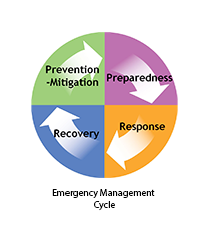What is Hazard Mitigation

Hazard mitigation describes actions taken to help reduce or eliminate long-term risks caused by hazards or disasters, such as flooding, earthquakes, wildfires, landslides, or dam failure. As the costs of disasters continue to rise, governments and citizens must find ways to reduce hazard risks to our communities.
- Preparedness activities are the emergency plans, training, drills, and exercises that individuals, communities and first responders participate in on an almost daily basis. These are things done to get ready for an emergency or disaster before it happens.
- Response is the short-term, emergency actions taken to address the immediate impacts of a hazard.
- Recovery is the longer-term process of restoring the community back to normal or pre-disaster conditions.
- Mitigation activities are actions that will reduce or eliminate losses, for anticipated future events. Mitigation can reduce or eliminate the need for emergency response and greatly reduce the recovery period.
The Federal Emergency Management Agency (FEMA) defines hazard mitigation as, “any sustained action taken to reduce or eliminate long-term risk to life and property from natural hazards.”
The purpose of the LHMP development process is to help reduce the impacts of natural hazards to the HVLCSD and the community it serves. Wildfire, drought, flood, and severe weather hazards are just a few of the hazards of concern to the District. While natural hazards such as these cannot be prevented, an LHMP forms the foundation for the District’s long-term strategy to reduce disaster losses by breaking the repeated cycle of disaster damage and reconstruction. Jurisdictions with a DMA-compliant, FEMA- approved LHMP are eligible for FEMA pre- and post-disaster grant funding and are better positioned to respond and recover when disasters occur.
Many types of mitigation actions are things done on a daily basis without much forethought such as purchasing insurance to protect a vehicle investment, putting on your seatbelt, or putting in gutters around a roof to better direct rain runoff. The same concepts apply to community-level hazard mitigation planning. Mitigation planning is a process for county, city, and local governments to identify community-level policies and actions that will reduce the impacts of natural hazards.
